
In part one of this blog series, we set out to answer the question of “how to get the right laser spot at the right distance?” As we went on to explain, this simple question doesn’t have a simple answer, especially when we are talking about single-mode fiber optics. In that post, we took the time to go through an introduction of Gaussian beam optics and provided a few examples of how that can be used to determine the lens you need to choose for a given spot size. In part two, we are going to explore the far more straightforward case of imaging a multi-mode laser beam. In this case, we can typically view the output of a multimode fiber-coupled laser as a flat-top beam, which enables the use of basic geometric optics. Since we can assume standard geometric imaging for multimode fiber-coupled lasers, we can simplify our answer to the spot size question to three different parameters: working distance, focal length, and numerical aperture.
Working distance:
In an optical system, the working distance is defined as the distance from the last optical surface to the object or image. While this is not exactly the same as the image distance, as a first-order approximation, it is usually acceptable to conflate these two values. The reason why we care about this is that there is a general rule of thumb for geometric optics that the magnification of any object is determined by the ratio of the image distance over the object distance. What this means is that a longer working distance will make a larger spot size. Hence, there is always a tradeoff between working distance and the laser spot size. Additionally, since this ratio determines the magnification, not the actual spot size, you must also take the fiber core diameter into account. Therefore, another general rule of thumb is that you cannot produce a spot size smaller than the core diameter of the fiber. So, for the smallest spot possible, you want to use the smallest fiber core diameter possible.
Focal length:
The working distance determines the magnification, but the focal length of the lens is what determines the working distance. As a result, it is crucial to have an understanding of the role that focal length plays when choosing a lens for producing the desired spot at the desired distance. The focal length of a lens is loosely defined as the distance from the lens where collimated light converges to a single point. As long as the object is located in front of the lens at a distance greater than the focal length it will produce a real image, and it will always be further from the lens than the focal point. Because of this fact, the larger the focal length of the lens the larger the working distance, and the shorter the focal length, the shorter the working distance. Since the working distance determines the magnification, it is safe to use the rule of thumb that the longer the focal length of the lens, the larger the spot size will be, and the shorter the focal length, the smaller the spot size will be.
Numerical Aperture:
The last optical parameter that we must take into consideration is the numerical aperture (NA). The NA of a fiber determines the divergence or angular spread of the light when it exits. For example, a 0.22 NA multimode fiber has a full angle divergence of roughly 25-degrees. Just as the NA of the fiber determines the maximum output angle of the light rays, the NA of the imaging lens will determine the maximum acceptance angle of that lens. Therefore, you must make sure that you always select a lens whose NA is slightly larger than that of the fiber. Luckily, since lens manufacturers are aware of this fact as well, there is a wide range of standard lens NA’s which are nicely matched to standard fiber NA’s. For example, 0.25 NA lenses, are the typical standard for use with a 0.22 NA fiber optic. It is important to note that the NA of a lens is inversely proportional to its focal length. Which adds a restriction on the minimum achievable working distance of the imaging system, and therefore the minimum spot size.
As you can now see there is no simple answer to “how do I get the right spot at the right distance?” In reality, it is a constant trade off between the working distance, focal length, and NA of your imaging lens, as well as the core diameter and NA of the fiber optic. While all of the rules described here are based on geometric optical principals these rules can also provide you with a good starting point for single-mode Gaussian beams as well. But, as discussed in part one of this blog to find the exact spot size and distance is a little more complicated than the ratio of the image distance over the object distance.
If you would like to get more detailed information on the fiber-coupled diode lasers offered here at RPMC Lasers, click here or, you can also talk to one of our laser experts today about your specific spot size and working distance needs by calling 1-636-272-7227.

 SHIPS TODAY
SHIPS TODAY 